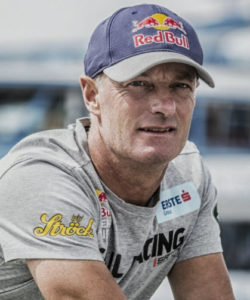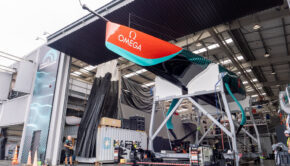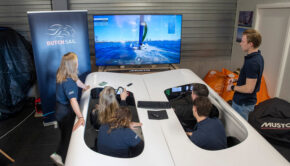Organizing the Youth America’s Cup
Published on January 17th, 2017
Two-time Olympic Gold Medalists Roman Hagara and Hans Peter Steinacher of Austria were the masterminds behind the first Red Bull Youth America’s Cup regatta in 2013, which was designed to provide young sailors a career pathway into the America’s Cup.
As Sport Directors, they remain the driving force behind the youth program that will set sail again in June 2017, and Steinacher kicked off the year with some personal insights…
Hans Peter, before we talk about the 2017 Red Bull Youth America’s Cup, can you tell us a little about the 2013 event that was held in San Francisco?
2013 was the first Red Bull Youth America’s Cup, so it was a new experience. The boat was the AC45, and the special thing was its wing rig. The rest of the boat was a normal, standard catamaran, but the wing rig was a new challenge for the sailors. In the whole world there were only a few boats existing with wing rigs, and in this age group of 19 to 25 they had absolutely no experience with it. That’s exactly what we wanted to do to find the best talent in the world. And it worked.
So what’s different about the Red Bull Youth America’s Cup this time?
The big difference is that the boats are foiling boats. And in 2013, the America’s Cup boats were 72 feet, while the Youth America’s Cup boat was 45 feet. Now the America’s Cup boat for 2017 is 49 feet and the Youth America’s Cup boat is 45, so there’s only 4 feet of difference. It’s very challenging for the youth sailors. That’s why we have to be really careful about how we select them, and we are giving a chance only to the teams that are really well prepared and well organized from the outset.
Are there any other differences?
In 2013 we had two teams from New Zealand and two teams from America. This time only one team per nation is allowed. Also, regarding the type of boat we’re using – the AC45 foiling that’s used in the America’s Cup World Series – only eight of them exist in the whole world, so we couldn’t sail on 10 boats like we did in 2013.
That means we have a Qualification Pool A and a Qualification Pool B, potentially with six boats in each if they do the preparation required and we give them all the okay to participate. The top four teams of Pool A and the top four teams of Pool B go into the Final, and then we have the eight best teams competing for the Red Bull Youth America’s Cup.
Where do these boats come from?
The boats come from all the America’s Cup teams that competed in 2016 in the Louis Vuitton America’s Cup World Series; so that’s six boats from currently existing America’s Cup teams, and two additional ones that are coming from the America’s Cup Event Authority. That’s a total of eight boats, and each will have a six-person crew.
So with the teams sailing the only eight boats in existence, it must be crucial to avoid crashes and other mishaps that might damage a boat.
We also have all the equipment that exists for these kinds of boats right in Bermuda. So while we don’t have a spare boat, we do actually have spare parts for everything. And we have a full shore team that can repair the boats overnight, though hopefully we won’t need that. We are very well prepared.
The Japanese team for the 2017 Red Bull Youth America’s Cup made news when they became the first to train on the AC45 foiling after the America’s Cup World Series event in Japan last November. What’s the format for practice sessions?
The Japanese had only two or three days after the Louis Vuitton America’s Cup World Series event in Japan, because that was convenient for them and in the rules we allow teams to sail a total of seven days on the AC45s before the official practice in Bermuda.
How hard is it to enforce that rule?
All the boats will have arrived in Bermuda by the end of January, so it’s easy for us to control that no team has an advantage. They’ll all have the possibility to sail a total of seven days before the official practice starts. Because the time is limited, they have to sail at a very high level every second they’re on the boat. In the meantime they are all preparing by sailing on different foiling boats.
And the teams themselves – are there any new countries to watch out for this year?
The Austrian team is new. They missed getting selected in 2013, but this time they passed. They’re really well organized and the sailors are quite strong, so they created a good team. Another new team is Spain, also very strong. In the selection they were really well organized and enthusiastic, and their mentality on the boats was excellent.
Are there any women on the teams?
At the moment, the teams have some female crew members on their lists. But keep in mind that right now there are between eight and 10 people on many teams. They will do their final selection in May to determine who will sail in competition.
What about sailors from the Red Bull Foiling Generation series that you and Roman Hagara developed to introduce foiling to 16- to 20-year-olds?
At the moment we have seven possible candidates for the Red Bull Youth America’s Cup from Red Bull Foiling Generation, but again, the teams will make the final decision about which six sailors they’re going with in May. The foiling AC45s are very, very physical boats to sail. You need a lot of power; and if you’re younger than 18 you don’t yet possess the full power you will have three years later. So we’ll see.
Is this the kind of project where you and Roman start planning the next regatta almost as soon as the previous one is finished?
Yes, because it’s very important that Red Bull Youth America’s Cup is part of the America’s Cup protocol. That means the six America’s Cup teams have their own Youth America’s Cup team, and also that we have access to their AC45s. They hand over the boats to us, and we have to give the boats back to them in the same condition.
What effect, if any, do you think the Red Bull Youth America’s Cup has had so far?
It used to be a lot harder for the young sailors to find their path. Actually, the Red Bull Youth America’s Cup changed the whole America’s Cup world – the age group that’s sailing on the boats dropped by about 10 years. For this America’s Cup, eight sailors from 2013 have found the pathway into America’s Cup teams – actually most teams now have a former Youth America’s Cup sailor. All the teams saw that the new boats fit the young generation exactly. They aren’t scared and are very good at handling the speed. So the sailing leaders of the world are picking younger sailors than before.
Red Bull Youth America’s Cup gets underway during the America’s Cup action in Bermuda this summer, with Pool A and B Qualifiers on June 12-16, 2017, followed by the Finals scheduled for June 20-21. For more info about the Red Bull Youth America’s Cup click here.
Background: The 35th America’s Cup has attracted six teams (5 challengers and 1 defender) that will compete in the new 15-meter AC Class, with a series of qualifiers beginning on May 26 that lead to the start of the America’s Cup Match on June 17. Complete schedule.
Source: ACEA










 We’ll keep your information safe.
We’ll keep your information safe.